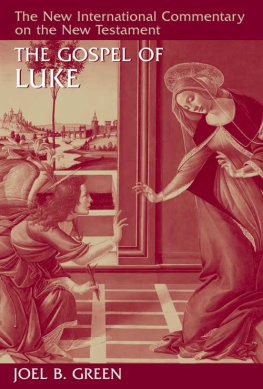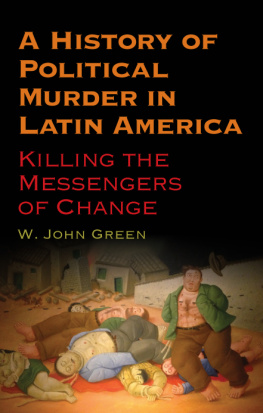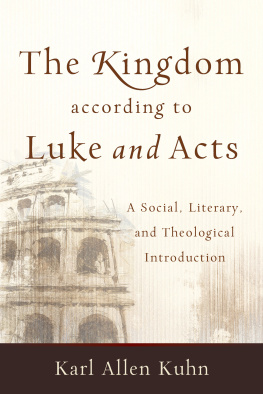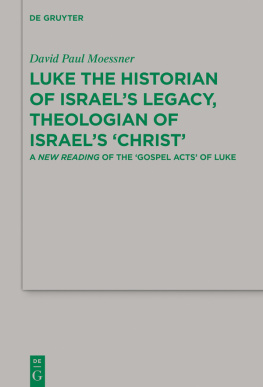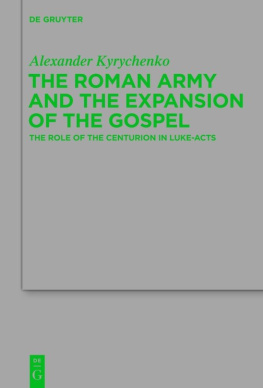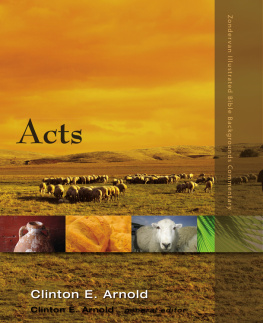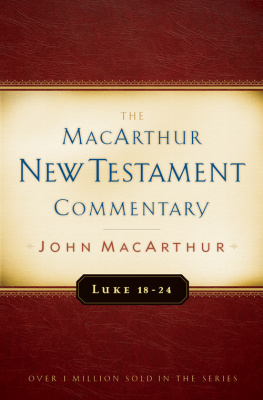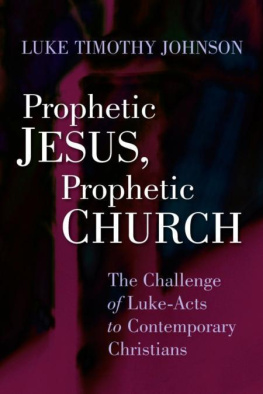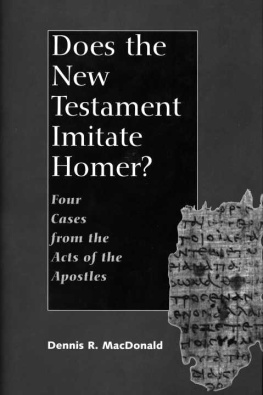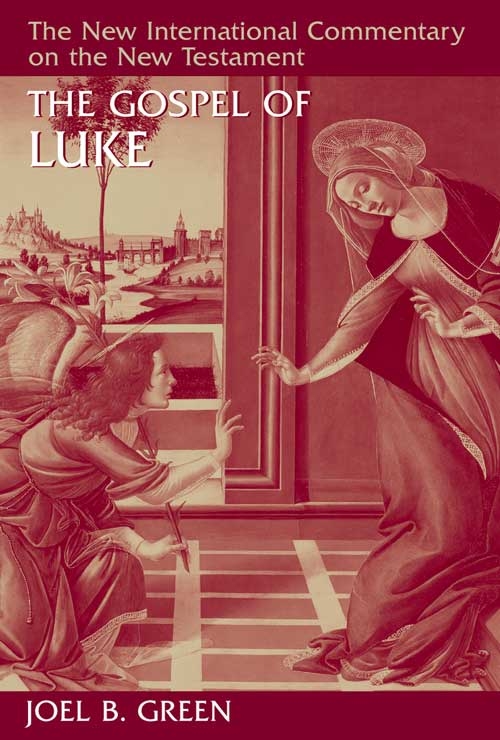
The Gospel of
LUKE
Joel B. Green
W ILLIAM B . E ERDMANS P UBLISHING C OMPANY
G RAND R APIDS, M ICHIGAN / C AMBRIDGE, U . K .
1997 Wm. B. Eerdmans Publishing Co.
2140 Oak Industrial Drive N.E., Grand Rapids, Michigan 49505 /
P.O. Box 163, Cambridge CB3 9PU U.K.
www.eerdmans.com
All rights reserved
Library of Congress Cataloging-in-Publication Data
eISBN 978-1-4674-2267-3
ISBN 978-0-8028-2315-1
The Scripture quotations contained herein are from the New Revised Standard Version of the Bible, copyright 1989, by the Division of Christian Education of the National Council of the Churches of Christ in the United States of America, and are used by permission. All rights reserved.
is from Power and Privilege: A Theory of Social Stratification by Gerhard E. Lenski. Copyright 1966, 1984 by the University of North Carolina Press. Used by permission of the publisher.
CONTENTS
INDEXES
This replacement commentary (the eighth) represents another milestone for the New International Commentary on the New Testament, in that it replaces the first commentary to appear in the original series, that by Norval Geldenhuys in 1951. For that volume, the first editor, Ned Stonehouse, wrote a general foreword introducing the series, while F. F. Bruce, who would eventually succeed Stonehouse as its second editor, wrote a foreword to Geldenhuyss commentary in particular. Reading these two forewords can be instructive with regard to the evolution of the series.
That the proposed seventeen- (now nineteen-)volume series would appear with some regularity is our yet-to-be-realized hope, which now looks to the turn of the century for final realization (Matthew, the Pastoral Letters, and 2 Peter/Jude are outstanding but in process). Whereas the international scope of the series has been maintained, its original Dutch and South African flavor has, with the present volume, now been lost. So also under Bruces editorship the intentionally Reformed perspective of the series envisioned by Stonehouse began to wane. The present volume, the second in the series by a Methodist (along with I. Howard Marshalls Johannine Epistles) is another indication of the cooperative, broadly based, cross-confessional dimension of the evangelical tradition that has emerged in the second half of the twentieth century. But the goal of the series has been maintained throughout all of this evolution: to provide earnest students of the New Testament with an exposition that is thorough and abreast of modern scholarship and at the same time loyal to Scripture as the infallible Word of God (Stonehouse, p. 3 in Geldenhuyss Luke).
Two further reflections from those first forewords are of interest regarding the present volume: the pointedly pastoral dimension of the Geldenhuys volume, and its way of being abreast of modern scholarship. The first matter, very frankly, disappeared from most of the succeeding volumes until it was reintroduced in my First Corinthians (1987); and I have urged current authors to work hard at maintaining this dimension of the series. The present commentary happily does so, although not in the more fixed form that Geldenhuys (or Fee) did.
The second matter is the more significant one regarding the present volume; for in some ways Geldenhuys and Green, at the midpoint and the end of the present century respectively, represent two considerably different approaches to these matters, while in both cases going against the grain of the atomistic approach to Synoptic studies that has so long held sway. In his foreword Professor Bruce noted that Geldenhuys maintained a healthy scepticism toward some parts of the critical stock-in-trade of the academy, which made it look a bit obscurantist for its time, despite Bruces demurrer to the contrary.
The present commentary is anything but obscurantist. But it is different from most Synoptic commentaries in its approach to the evangelist Luke, showing very little concern for traditional form-critical and redaction-critical issues. Professor Green is fully aware of these matters, but leaves the reader to consult other commentaries for their details. His concern, and it is a refreshing and exciting concern, is that the reader capture Lukes narrative of Jesus on its own right. Here at last is a commentary on Luke that tries to help the reader to see how the narrative works, how Lukes own obvious concerns drive the narrative from beginning to end (including Acts), how one should read Luke as its first reader would have read itwithout cross-referencing to Matthew or Mark. Thus I am pleased to commend this superb reading of Luke to both the primary audience of the seriesthe working pastor and teacher, as well as studentsand its secondary audience in the academy. Read it and learnand enjoy,
Also belonging to the newer generation of evangelical scholars (see my preface to Doug Moos Romans), Joel Green is especially well-equipped for this task. Since the completion of his Ph.D. in New Testament in 1985 (from Aberdeen, Scotland), he has maintained a vigorous schedule of publications, especially on Luke-Acts (see the entries in his bibliography), as well as serving as editor (or co-editor) for a whole variety of projects (Catalyst, a quarterly for seminarians; the Dictionary of Jesus and the Gospels [IVP]; the I. Howard Marshall Festschrift; and others). He also already has a distinguished teaching career at New College (Berkeley) and the American Baptist Seminary of the West (Berkeley). As of the publication of this volume (Fall 1997) he begins his appointment as Professor of New Testament Interpretation at Asbury Theological Seminary, Wilmore, Kentucky. However, throughout all of his academic life, both as a student and teacher, he has also maintained an active pastoral life in the church. This combination of passion for scholarship and the life of the church has come to a splendid fruition with the present commentary.
G ORDON D . F EE
If the name of Hans Conzelmann is associated with the massive shift in Lukan studies characterizing the decades reaching from the 1950s to the publication of Joseph Fitzmyers two-volume commentary on the Third Gospel in the 1980s, any survey of more recent exploration of the Gospel of Luke would highlight the work of such scholars as Robert Tannehill and Luke Johnson on the literary side, and Halvor Moxnes and Philip Esler on the social-scientific. My own introduction to serious study of Luke coincided with this latter shift, marked by the waning of the hegemony of historical study (historical criticism, tradition criticism, redaction criticism, and the rest) and the blooming of so-called newer approaches (e.g., new literary criticism, narrative criticism, new historicism, and the like). At the time, even the idea of writing a commentary seemed to present too many problems of method and presentation; indeed, more than one person pronounced a plague on all commentary writing! My decision to undertake this project was grounded in my belief that those involved in the churchs ministry continue to be helped most by commentaries on whole books, written from the perspective of a fundamental reverence for the biblical text and from a position of critical engagement with academic biblical studies and active involvement in the life of the church. I also believed that discussion about method in the study of the Gospels need not lead necessarily into a cul-de-sac, and that recent innovations in method had as their natural outcome the possibility of making the Gospel of Luke and its message come even more alive for contemporary readers.
How I have navigated the sometimes difficult, always exciting waters of interpretive method will become clear to any who actually (!) read the Introduction. It will become equally clear that, in spite of the size of this volume, I have made no attempt to address the whole spectrum of questions that might possibly be put to the Gospel of Luke. This has never really been possible, and it is even less so today. This is not for me a cause of despair, but rather reason to rejoice, and to reflect on the multivalency of the Gospel, which can address in so many ways the diverse needs of the historic and global church.
Next page
